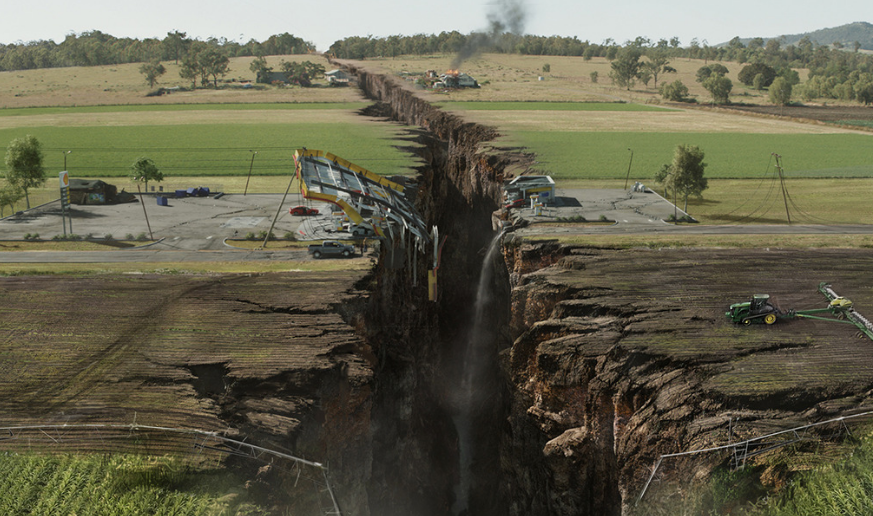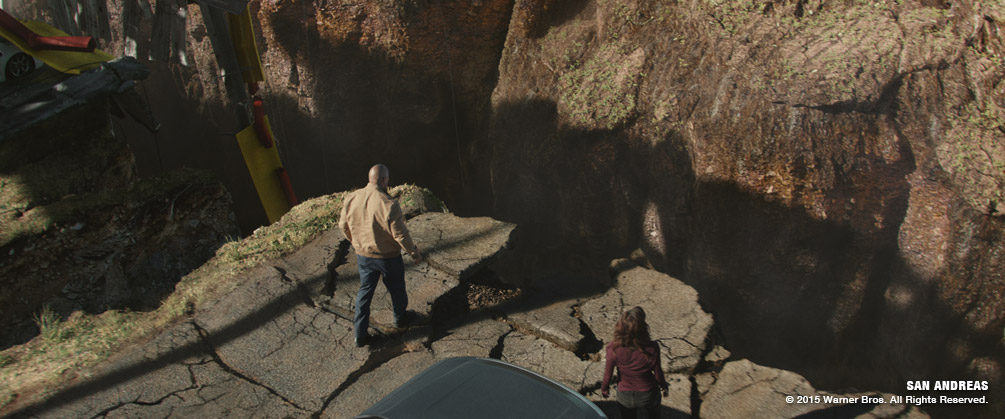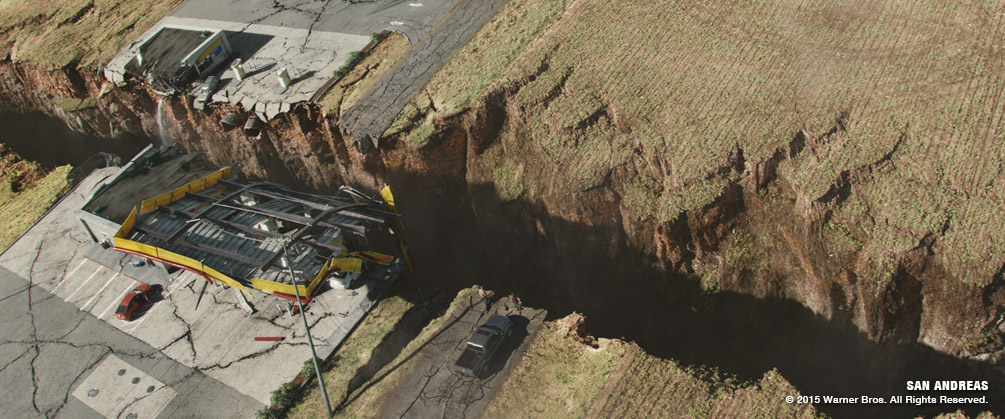San Andreas Case Study

Case Study
Photorealism is the Holy Grail of visual effects, and yet also one of the art form’s most challenging propositions. Read on to find out how Image Engine tackled the issue head-on in a ground-breaking shot for natural disaster movie S an Andreas.
Natural disaster movies can’t cut corners when it comes to visual effects. After all, while you might be able to wire up a ton of explosives to bring down a fivestorey office block or close off a length of highway to film a highvelocity car chase, there are no practical effects that can safely – or feasibly – tear open the very earth itself. And that’s where Image Engine came in on Brad Peyton’s California nightmare, San Andreas.
In the film, Dwayne Johnson (a.k.a. The Rock) plays Chief Ray Gaynes, a Los Angeles Fire Department helicopter pilot who heads to the skies for what will unarguably turn out to be his worst day on the job yet. A devastating earthquake is about to hit the North American west coast; the grinding of continental plates causes the City of Angels to shift and undulate, with entire skyscrapers crashing down around our intrepid protagonist.
Clearly, practical effects were not up to the task. As such, Image Engine was one of many vendors brought on to apply its visual effects skills to a vision of a world torn asunder….

The Preparation Process
Image Engine’s work on the project included the creation of a full CG rural landscape that had been torn apart by the earthquake. “It was a big task – and we also had a handful of other shots that included aspects of the crevasse devastation from different camera angles,” says Martyn Culpitt, visual effects supervisor.
“We were a pretty small team on San Andreas– probably around 30 people,” he continues. “There was Eric Gronfeldt, our senior look dev artist (a.k.a. ‘the cliff guy’) at Image Engine. Then there was Geoff Pedder, who was one of our senior lighters and worked on the look dev and creation of the gas station. Then we had another couple of guys creating the full hero road, with broken-up pieces of concrete and asphalt – they had to create superhigh detail for that.”
It was creating the sweeping hero shot of the crevasse – an 85 ft wide and 300 ft deep fissure in the earth – that comprised the bulk of Image Engine’s work, and it was no mean feat. The amount of detail required was momentous, and nothing less than total photorealism was required to sell the audience on the shocking nature of the shot.
In order to ensure things ran smoothly, Culpitt carried out an extensive preproduction process and sought signoff on all elements from an early stage.
“We have an in-house concept artist, Rob Jenson, who is just fantastic. His eye is incredible,” says Culpitt of the project’s early stages. “I sat down with him before we actually started production and got him to rough out ideas of the cliff. The client had given us live-action plates, so we mocked the shot up on the plates first and worked from that. We sent multiple versions and ideas to the client and director, and they bought off on the overall idea of it.”
The next stage was to ensure layout and camera movements were also set in stone, meaning full attention could be given over to building and detailing the crevasse itself.
“It’s best to get the layout done before you progress too far down full production,” explains Culpitt. “For example, you don’t want to create anything that’s going to be out of shot and not seen by the audience – it’s just a waste. So the client bought off on our general layouts early on.
“We created multiple camera moves based on the real-world movement from the onset dolly rig,” he continues. “I think it’s best doing camera moves based on physical kit as you’re getting a realworld view. Initially we had a shot that flew around the crevasse and gave a bird’s eye view of it, which was cool, but when I look at the shot now I think it looks better from a more realistic camera view, as it grounds the shot in the reality of the film, enhancing the tension.”
The live-action photography that Culpitt and the team worked from saw Dwayne Johnson and co-star Carla Gugino stepping out of a car and staring in shock at the earth-shattering sight. The camera follows Johnson as he walks over to the crevasse edge and looks out – the camera then pulls out as far as it was physically able on the on-set crane. “We extended that camera move so it went up to a massive expanse, taking in the whole view, so you’re seeing a vast area of the fissure. The challenge there was linking up the camera move so it all felt pretty fluid.
“Once we had sign-off on the layout and camera moves, we could start building the cliff and progressing the quality of it to the detail that was needed.”

Breaking Open the Earth
The biggest challenge on the San Andreas project came in developing the appropriate amount of detail for chasm – a huge cleft through an expanse of rural California, and a sign of the further devastation that is to befall the west coast.
“The detail required for the CG cliff was immense,” remembers Culpitt. “We’re seeing it at 85 feet across, so as you swing around in the shot you’re seeing it full-frontal – there’s really nowhere to hide.
“We kept pushing and pushing, believing that it was not photographic enough, so we really had to delve deep into the skill set at Image Engine. We had to figure out how to make it feel within the realms of reality, rather than like a massive CG abyss that couldn’t actually exist.”
As with most photo-real CG work, the first step was to find accurate references – the only problem being that the earth has never actually torn asunder in such dramatic fashion. “We’ve never actually seen what that looks like, other than small cracks,” says Culpitt. “There was one crack in Mexico, however, called Hermosillo Sonora – it was far less dramatic, but it helped. We could see how it opened up in a natural fashion. However, as far as the textures and detail of the inner wall and how the ground would crumble as the soil would pull apart – that reference was pretty difficult to find.”
Once the team had a solid idea of what they needed to achieve, Maya was used to create the main scene, and Mudbox and ZBrush for sculpting. The team also used Houdini to create effects such as water spilling from broken pipes jutting from the sides of the cliff, and rocks, boulders and dust crumbling from the edges.
“A long time ago in the industry, we could just do matte paint projections work, but you can’t get away with that nowadays, especially when you have such a big camera move,” says Culpitt. “You need the fine, absolute detail that you can only get from creating the scene in CG. So that’s what the team did here: build the geo and then displaced and textured it and built shaders to work with the different layers. A lot of time and R&D was spent on the development of this at the same time as building the shot.”
This R&D saw the team work out how to incorporate all the millions of layers of plants, leaf litter, small rocks, sticks, tire tracks and plant row displacement detail, as well as fine displacement details for the walls of the cliff, and then render it all. “With so much geo the scenes tended to get incredibly heavy and became very hard to work with,” says Culpitt. “We developed new ways to help these issues – part of the fix was using our procedurals/layout workflow development.”
The depths of the crevasse needed just as much attention as the surface detail. “Our cliff faces started with all of these different illustrations of rocks and clay, and then as we got deeper to the denser layers of bedrock and the base of the actual crevasse we have big boulders and a river,” explains Culpitt. “We got one of the guys here to shoot some footage of the Capilano River in Vancouver and then projected those textures onto the geo in the base, rather than actually creating the water. You can get away with that as it’s so dark – all you’re really seeing is the movement of the water. We did, however, add some effects particles on top to give it a certain mistiness.”

Field of Dreams
It wasn’t just the torn-apart earth that required creation, but also the environment surrounding it. The full hero shot of the cliff needed to be fully synthetic, meaning the camera moves, the background and everything else in the shot – including the gas station, truck and stretches of open field – had to be created in CG.
“We tried different ways and variations of doing it, including things like matte painting, but it didn’t work – with the parallax that’s happening with the camera, you have to build the whole thing,” says Culpitt. “So, all of that had to be high textured with full detail. The fields for the main area needed a lot of detailed work. I can’t even fathom how many polygons we had – just millions and millions of faces.”
To achieve this level of visual fidelity, the team built incredible amounts of surface detail, including soy plants for the fields; leaves; small rocks; bits of twigs; and other leftover debris – all to add a sense of reality that flat textures alone could not conjure up.
“Right up to the very end of the project, we were thinking about how this shot could be made better and better,” remembers Culpitt. “For instance, over the Christmas break, I’d gone back to my wife’s parents’ farm in Ontario. I started going around the fields there with a stepladder so I could take photos looking down on the fields. That was a good reference – when you can actually look at something like that, it really changes your way of thinking. When I came back I really had a much better idea of the kind of detail we were going to need to sell the scene.”
Eric Gronfeldt built the cliff and then displaced and inserted tyre tracks on the top of it, as well as plants and fine breakout detail. Michael Billette, a 3D modeler and layout artist, also created several new ways of texturing the ground with plants based on procedurals. “Doing it this way made things feel random and organic – it wouldn’t have felt quite so naturalistic had we done it by hand,” says Culpitt. “Thanks to ideas like this, and once we got that detail in there, we felt that we’d really hit the mark. After that, it was just about cleaning everything up and making sure that the overall shot was working.”
Making a Scene
The end result is impressive indeed – a 300ft chasm that couldn’t be achieved by anything other than the dedication and hard work of an experienced visual effects team.
“It was a challenge that we had to face head-on to figure out,” says Culpitt. “We knew going into the project that it was going to be difficult to meet the high expectations and the detail needed to sell the photorealism of the shots. Yet thanks to everyone working together we pulled it off. We definitely pushed ourselves and learned a lot from the experience. The final shots look fantastic and I couldn’t have done it without the team we have at Image Engine – the guy’s efforts were unwavering, even when it got really challenging.
“We’re like a family here at Image Engine – we work well together, everyone looks out for each other and there are no egos. That kind of working environment makes projects like San Andreas possible.”

